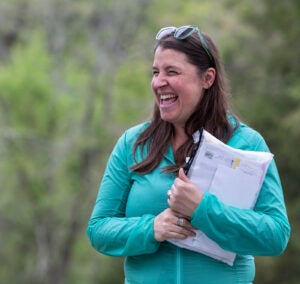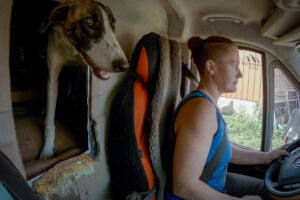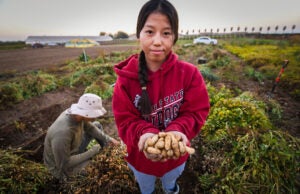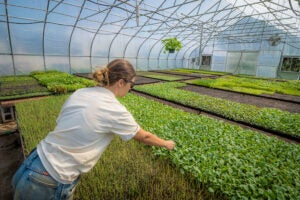As the agricultural sector struggles with an aging workforce, the recruitment and retention of agricultural workers is more important than ever. One demographic that is having greater influence on the sector is women, who made up 36 percent of total farmers, according to the latest U.S. Department of Agriculture’s Census of Ag data.
Though farming has historically been male-dominated, women are entering the agricultural workforce more than ever before. Farming is not known for being an easy profession — farmers deal with changing weather conditions, injury hazards, and oftentimes razor-thin profit margins.
Many female farmers, however, report experiencing addition barriers. Issues stemming from internal and institutionalized sexism lead to various issues that women in agriculture face, such as sexual harassment in the field, unique land access challenges, even tighter economic margins, and a 5 percent to 6 percent lower hourly wage compared to their male counterparts.
As more women enter the agricultural sector, the challenges and issues they face need to be better understood and addressed. Gabrielle Roesch-McNally, who serves as director for American Farmland Trust’s Women of the Land Initiative, spoke about the unique challenges that women face and how different projects housed under Women of the Land are tackling these issues.

Roesch-McNally is a social scientist who has spent the past two decades working at the intersection of agricultural sustainability and equity. After obtaining her Ph.D. from Iowa State University and working at the USDA, she said she felt called to her position with American Farmland Trust, where she could purposefully do more applied work.
“I asked myself, ‘How do we develop programs that help drive change?’,” and Roesch-McNally has since developed projects and learning circles where women in agriculture can gather and connect over practical farming practices, legacy planning, and other farm viability issues.
Because the agriculture sector can be heavily male-dominated, “women often feel like they are an outsider in the group,” said Roesch-McNally. “Women [in these spaces] don’t feel like they have a voice, and they don’t feel welcome. So, women like women-centric spaces.”
Women for the Land has three main initiatives: to facilitate peer-to-peer learning to engage women in agriculture, to conduct research into barriers that women face, and to advocate for better policy which can address these barriers.

As part of Roesch-McNally’s research into identifying barriers that women face, she and colleagues published The State of Gender Equity in U.S. Agriculture, a report summarizing women’s challenges while providing recommendations on what can be done to help women overcome these challenges.
Overall, Roesch-McNally’s research communicates how women in agriculture across the U.S. experience common themes in the challenges they face. She and her colleagues specifically list six core categories of challenges for women:
- hazards in the field,
- smaller farm size compared to male counterparts,
- unique barriers to land access,
- smaller economic margins,
- less government aid in programs,
- and lack of access to farm financing knowledge.
While each of these warrants its own deep dive, Roesch-McNally provides concise and direct evidence and context for why women face these issues in ways uniquely tied to their identity as a woman.
“Women might be less likely to go for opportunities they might mistakenly see themselves as less ‘qualified for.’ This could apply to grant opportunities for farms,” the gender equity report noted. “From behavioral economics, we know that nudges are really impactful. Has USDA investigated whether they can nudge underserved people via those mechanisms? Are there ways that women and others are seeing something as not for them?”
Additionally, Roesch-McNally strives to provide actionable ways that can tackle these problems, and elaborates on how these initiatives would help sustain and support women in the agricultural sector. For example, Roesch-McNally and her team highlight the issue of inheritance and land stewardship for farmers. Farms historically are a family business, and farmland is passed down through generations to preserve farming practices and maintain a sense of community.

Historically, farms were passed down to sons, not daughters — there was a stereotype that it was just expected for sons to “return home to the farm” while daughters would find another path.
Roesch-McNally said this assumption actively hurt women who come from generational farmer families and who expressed interest in taking over their families’ operations. It can often exacerbate an already difficult conversation for families.
Given the difficulties of farming today, it’s also no surprise that children in generational farming families are choosing not to continue their farming legacy, opting for careers outside of farming. This creates a problem for current farmers as they create succession plans and seek heirs for their farm.
“Some families are recognizing that to keep the land in their family, they have to look at all heirs, not just men,” Roesch-McNally said.
Conversely, some women are thrust into the role as the only family members willing to continue the farming operations, and because there are instances where they may not be adequately prepared, “They struggle to access resources to get them confident and capable to manage and make decisions,” Roesch-McNally said.
With succession planning and inheritance of farmland being such a critical moment in whether a farm carries on with its operations, it is vital for farmers and those involved in the process to factor in the unique challenges that female heirs face and address those problems.
“I think one of the challenges they face is a loss of femininity. Women didn’t want to get stereotyped as unfeminine,” one contributor to the gender equity report stated. “Women are worried about being perceived as unfeminine or having their intelligence questioned. The condescension happens all the time, even when people think they are being are helpful.”
And there’s a very tangible aspect to some differences between men and women.
“I don’t think it’s insurmountable, but it is a physical job,” another person in the report said. “Being conscious of right sizing stuff for women’s operations is necessary . … I mean, the height of a jackhammer [for example]. I can’t use a jackhammer, I’ve got to give it a bear hug to pull it out. A lot of power tools and equipment are made to be operated by people that are bigger and stronger. I’ve got to hire somebody for cheap for those tasks.”

Another stereotype that Roesch-McNally discusses is the idea that female farmers tend to be more environmentally friendly than their male counterparts.
“There’s this stereotype of women that they will take care of children and family … this stereotype translates into women taking care of farmland, a conditioning of sorts that men don’t experience,” she says.
As many farming families know, women have been involved in farms for a long time — often tasked with doing the books and keeping financial records for the business, for example — but “the perception of a farmer is always a man in the tractor, working the field” said Roesch-McNally. “These narrow perceptions need to be expanded, and the [role of] caregiver of the land can be broadened.”
Roesch-McNally elaborates on how this stereotype can hurt women hoping to jump into larger-scale commodity farming, and improve female retention in industries that are more mechanized and possibly larger scale.
“There is this perception of ‘real farming’ that women should not get involved in,” said Roesch-Mcnally. “I hope to see less pigeonholing for what [roles on the farm] entail, including for men.”
By addressing the issues that women face and acknowledging the stereotypes that so often are placed upon them, farmers and those in the agricultural sector can begin to understand how to better treat women and retain them in the sector.
To ensure that the future of farming is prosperous, developing robust and multi-faceted solutions are necessary in order to support a growing subset of those in the agricultural sector: female farmers.
Liza Thuy Nguyen served as the 2023 American Farmland Trust Agriculture Communications Intern at AGDAILY, with a focus on helping to amplify diversity and minority voices in agriculture. Liza is originally from Anaheim, California, and attended the University of California, Davis, as a first-generation college student. She received a bachelor’s degree in genetics and genomics and went on to earn a master’s in horticulture from Penn State.



